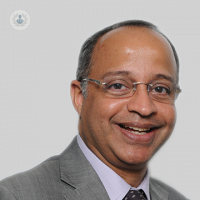Cholesteatoma: why is treatment necessary?
Autore:Accumulation of skin cells in the middle ear is called cholesteatoma. The cells form a cyst, which is filled with air or fluid. The lump starts deep in the ear next to the eardrum and grows toward the middle and inner ear. Although cholesteatomas are not cancerous (benign), if left untreated they can lead to problems such as hearing loss.

Leading London otolaryngologist Mr Abhijeet Parikh explains why it’s important for cholesteatoma to be treated and what possible complications could arise in the ear if it isn’t…
Why does a cholesteatoma need treatment?
Cholesteatoma needs treatment:
a) To stop ear infection(s)
- Skin cells are a rich source of nutrients for bacteria that cause an infection. This leads to a characteristic foul-smelling discharge from the ear.
b) To stop hearing loss
- As it grows within the small middle ear space, the cholesteatoma erodes the small bones that transmit sound (ossicles). This causes a progressive hearing loss.
c) To prevent other complications (uncommon)
- Important structures around the middle ear such as the balance system and facial nerve can be involved in the erosive process leading to imbalance, vertigo and facial palsy.
- Rare complications include meningitis or a brain abscess if the cholesteatoma breaks through the confines of the small middle ear space and abuts the brain and its lining.
What are the symptoms of cholesteatoma and how is it diagnosed?
If you have cholesteatoma its main symptoms are:
- Foul-smelling discharge from the ear, sometimes bloodstained
- Progressive hearing loss
- Diagnosis is made on ear examination
- Examination with a microscope and suction cleaning of any discharge is very useful to gauge the extent of the cholesteatoma
- A CT scan is done to further evaluate its extent and closeness to vital structures mentioned above.
How is cholesteatoma treated?
Infection and foul-smelling discharge can be treated by cleaning the ear (micro-suction) and a short course of topical antibiotic drops.
However, the definitive treatment of cholesteatoma is surgical. The procedure is called a mastoid exploration. The aim of surgery is to remove the cholesteatoma, preventing its progression and complications as mentioned in 2c above. The disease can recur, and thus more than one operation may be needed for complete removal. Repair of the ossicles and improvement of hearing can be addressed during surgery but is not its primary aim.
If you are concerned that you have a cholesteatoma, do not hesitate to book an appointment with a specialist.


